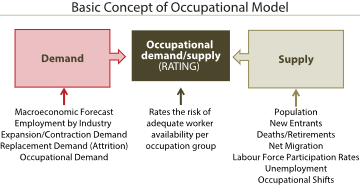Updated: June 2023
Main—Download | Definitions | Methodology | Occupational Classification
The occupational demand projections and the associated job prospect ratings were prepared by the Economics Division of the Department of Finance using the Newfoundland and Labrador Occupational Projection Model. The basic concept of the model is illustrated in the figure.

From a demand perspective, the macroeconomic forecast is produced using the Newfoundland and Labrador Econometric Model (NALEM) which utilizes a collection of historical data and assumptions regarding the Canadian, United States and world economies and the level of activity in the province’s key industries. The assumptions regarding provincial industries are based on inputs from and consultation with the appropriate provincial government departments.
The macroeconomic forecast forms the basis for employment demand by industry, and this employment by industry is used to produce occupational demand.
Data from the Statistics Canada 2021 Census were used to determine occupational concentrations among industries and to project the employment demand by occupation. The occupational data are based on the National Occupational Classification 2021 (NOC 2021).
Replacement demand (Attrition) by occupation was projected using retirement rates and death rates by occupation from the Canadian Occupational Projection System (COPS) which is developed and maintained by Employment and Social Development Canada.
From the supply side, the Department of Finance’s population projections formed the basis for the estimates of new entrants and net migration. The population projections are based on a number of assumptions regarding fertility rates, mortality and migration, and are consistent with the aggregate labour supply and demand projections in the macroeconomic forecast.
Historical estimates of labour force, employment, employment by industry, participation rates by age and sex, and unemployment rates were sourced from the Statistics Canada Labour Force Survey.
Historical counts of taxfilers by detailed industry were sourced from the Income Statistics Division, Statistics Canada. These data were used to derive the number of workers by industry.
Ratings Explanation
Analysis was carried out on the 187 occupational categories taking both supply and demand considerations into account to identify each occupation’s job prospects over the 2023 to 2032 period. This analysis included employment growth rates (historical and projected); attrition; new entrants; participation rates; age of the workforce; unemployment; and migration.
The occupations have been rated on a scale from 1 to 4 that gauges the likelihood of labour supply meeting labour demand for a specific occupational group.
The following key is provided to assist in the interpretation of job prospects for various occupations over the 2023 to 2032 period in Newfoundland and Labrador:
Occupation Rated as 1:
Projected labour supply is expected to be able to meet projected job openings, and an excess supply of workers may exist (i.e., excess supply of labour).
Occupation Rated as 2:
Projected labour supply is expected to be able to meet projected job openings (i.e., balanced labour market).
Occupation Rated as 3:
Projected labour supply to meet job openings will require increased labour supply responses (i.e., in-migration, higher participation rates, inter-occupational shifts). Additional supplies of qualified workers to meet unanticipated short-term increases in demand in the province are limited (i.e., demand for labour may exceed supply).
Occupation Rated as 4:
Projected labour supply is expected to lag projected job openings. Significant labour supply responses (i.e., in-migration and inter-occupational shifts) will be required to meet demand. Competition for qualified labour will be strong (i.e., excess demand for labour).
Questions and requests related to the projections should be addressed to the Economics Division.
